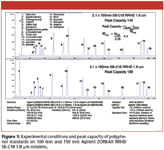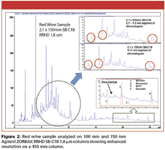Enhanced Peak Capacity for Polyphenols in Wine Using a Longer Agilent ZORBAX RRHD StableBond C18 1.8 µm Column
Greater peak capacity and resolution can be easily obtained for gradient analysis of complex samples by using sub-2 µm particles in longer column lengths.
Judy Berry and John Henderson, Agilent Technologies, Inc.
Red wine is a complex mixture and a rich source of polyphenols, compounds that have gained considerable interest due to research suggesting their many health-related benefits. In addition, polyphenols contribute to sensory properties such as color, flavor, and astringency. Therefore, a method of analysis is required that gives the necessary peak capacity for accurate identification and quantitation.

Figure 1
Results and Discussion
Greater peak capacity was obtained with a 150 mm ZORBAX RRHD SB-C18 1.8 μm column (Figure 1) for the gradient separation of 19 polyphenol standards where peak capacity increased from 140 to 188. Under gradient conditions, peak capacity is the most common metric to assess resolving power. A formula for conditional peak capacity was used that is reliant on retention time and 4σ peak width. A noticeable increase in resolution and peak detail is observed in Figure 2 for the 4–11 min segment for the 150 mm column. The red-circled areas are three examples where resolution has improved with the 150 mm SB-C18 column. An enlargement of the 18–26 min area of the wine chromatogram (150 mm column) clearly shows the presence of the well-known polyphenol Resveratrol as well as Quercetin and Myricetin by retention time matching of standards. The easy transfer of the method from the 100 mm to 150 mm column only involves increasing the gradient times and injection volumes by a factor of 1.5. UV detection was used in this case, but the presence of formic acid in the mobile phase also permits the use of MS detection.

Figure 2
Conclusion
The longer length of the 150 mm ZORBAX RRHD SB-C18 1.8 μm column allows complex separations to be done with high resolution and moderate analysis times.
References
(1) Chiara Cavaliere, Patrizia Foglia, Riccardo Gubbiotti, Paolo Sacchetti, Roberto Samperi and Aldo Lagana, "Rapid-Resolution Liquid Chromatography/Mass Spectrometry for Determination and Quantitation of Polyphenols in Grape Berries," Rapid Communications in Mass Spectrometry, 22(2008) 3089–3099.
(2) Xiaoli Wang, Dwight R. Stoll, Peter W. Carr and Peter J. Schoenmakers, "A Graphical Method for Understanding the Kinetics of Peak Capacity Production in Gradient Elution Liquid Chromatography," Journal of Chromatography A, 1125 (2006) 177–181.

Agilent Technologies, Inc.
2850 Centerville Road, Wilmington, DE 19808
tel. (800)227-9770; fax (302)633-8901
Website: www.agilent.com

Analytical Challenges in Measuring Migration from Food Contact Materials
November 2nd 2015Food contact materials contain low molecular weight additives and processing aids which can migrate into foods leading to trace levels of contamination. Food safety is ensured through regulations, comprising compositional controls and migration limits, which present a significant analytical challenge to the food industry to ensure compliance and demonstrate due diligence. Of the various analytical approaches, LC-MS/MS has proved to be an essential tool in monitoring migration of target compounds into foods, and more sophisticated approaches such as LC-high resolution MS (Orbitrap) are being increasingly used for untargeted analysis to monitor non-intentionally added substances. This podcast will provide an overview to this area, illustrated with various applications showing current approaches being employed.

















